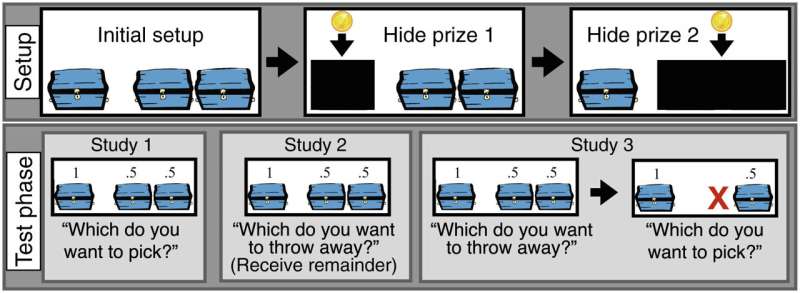
Developmental stages in children at young ages happen rapidly, considering the comparatively more leisurely changes that young people experience when they’re older; many parents will relate—often with haunted, shell-shocked expressions—that the differences between a two-year-old and a three-year-old are vast and challenging. Cognitive psychologists at Harvard University recently conducted a study exploring whether young children develop the ability to consider alternative possibilities when planning, and at what ages.
If a prize is hidden inside a single occluded container and a second prize is hidden in one of an occluded pair, then choosing the single container maximizes the expected reward. But about half of the time, three-year-olds will choose one of the pair, either of which might be empty—”might” being the operative word. As the researchers established across three studies detailed in a paper published in Proceedings of the National Academy of Sciences, three-year-old children don’t deploy possibility concepts like “might,” and thus can’t represent that one of the two containers might and might not contain a prize.
The wise decision in this prize-occlusion scenario is to pick the single container rather than one of the pair. Yet, as the researchers write, “young children make surprisingly unwise decisions in the face of multiple possibilities.” Older two-year-olds pick wisely 50% of the time—”like chimpanzees,” the authors note. Three-year-olds choose wisely 60% of the time.
Finding this behavior to be highly replicable, the researchers wondered what drives this computational process. The children know the location of the prize in the single container. But they mentally simulate the other prize going into one of the two containers, and, unable to deploy possibility concepts, regard this simulation as a fact rather than one of two possibilities.
There are several ways this computational error could arise: The researchers note that the children could have a side bias to right or left; they could focus only on one prize during the setup phase; or they may be choosing completely at random. They sought to test these hypotheses across three studies.
Study 1: Pick one of three
The first study simply sought to replicate earlier findings that three-year-olds choose wisely 60% of the time. A group of 20 three-year-olds participated in four test trials, choosing one box to receive the contents. The results closely approximated those of the previous study.
By applying a Bayesian generalized linear mixed model to the results, the researchers determined that the children were not choosing randomly. The two subsequent studies were designed to adjudicate between three hypotheses: that children deploy possibility concepts; that they deploy minimal representations of possibility; and that they deploy these low-level strategies in the three-container task.
Study 2: Throw away
In the second study, the children were taught to throw one box away and receive the contents of the remaining two boxes. Those children deploying possibility concepts or minimal representations of possibility should be expected to throw away one of the pair the majority of the time.
The researchers note that if children were choosing randomly, the results should be similar to those of the first task. But in the study, the children reliably threw away one of the pair, ruling out the hypothesis that they were deploying a low-level strategy; thus, the children were either deploying minimal representations of possibility or, having been prompted to think about which container is empty, they were deploying possibility concepts like “might.” Study 3 was designed to adjudicate between those hypotheses.
Study 3: Throw away and pick one of two
The third study, involving 24 three-year-olds, consisted of eight trials in which the children threw away one box and then chose to keep one of the two remaining boxes. The children threw away one of the pair more often than expected by chance, replicating the results from study 2.
After throwing away one of the pair, the wise decision is to pick the single box, as the remaining box of the pair might or might not contain a prize. Children who deploy minimal representations of possibility, i.e., believing their mental simulation was fact, would believe both remaining boxes contain a coin, and should thus choose wisely half the time.
In study 3, the children chose the single box rather than the remaining box of the pair 50% of the time; thus, the weight of the evidence suggests the children were deploying minimal representations of possibility and not robust possibility concepts (“might” or “might not”).
The researchers suggest that children may have possibility concepts but that performance issues in the tasks could prevent children from deploying them. Future studies could develop novel tasks with multiple performance demands in order to explore these possibilities.
More information:
Brian Leahy et al, Minimal representations of possibility at age 3, Proceedings of the National Academy of Sciences (2022). DOI: 10.1073/pnas.2207499119
Journal information:
Proceedings of the National Academy of Sciences
Source: Read Full Article
